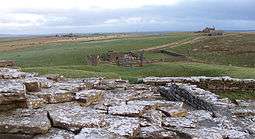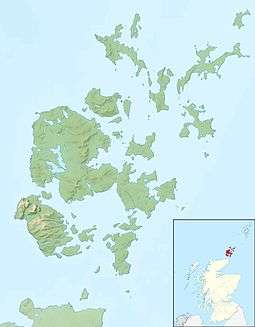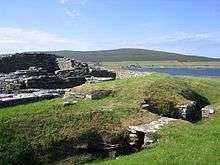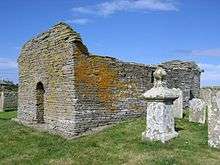Wyre, Orkney
Wyre is one of the Orkney Islands, lying south-east of Rousay. It is 311 hectares (1.20 sq mi) and 32 metres (105 ft) at its highest point. It is one of the smallest inhabited islands in the archipelago.
| Norse name | Vígr[1] |
|---|---|
| Meaning of name | spear head[2] |
 Wyre, viewed from Cubbie Roo's Castle, with the ruined chapel and burial ground visible. | |
| Location | |
 Wyre Wyre shown within Orkney | |
| OS grid reference | HY445262 |
| Coordinates | 59.12°N 2.97°W |
| Physical geography | |
| Island group | Orkney Islands |
| Area | 311 ha (1.20 sq mi) |
| Area rank | 85 [3] |
| Highest elevation | 32 m (105 ft) |
| Administration | |
| Sovereign state | United Kingdom |
| Country | Scotland |
| Council area | Orkney |
| Demographics | |
| Population | 29[4] |
| Population rank | 59 [3] |
| Population density | 9 people/km2[2][4] |
| References | [5][6] |
Orkney Ferries sail from the island to Tingwall on the Orkney Mainland, Egilsay and Rousay.
History
Wyre's history is still very apparent, and it has two ancient monuments maintained by Historic Scotland, Cubbie Roo's Castle and St Mary's Chapel.
Bishop Bjarni grew up on Wyre, and was the son of Kolbein Hruga (see Cubbie Roo's Castle below), Collins Encyclopaedia of Scotland says of him that he:
- "composed the only significant work of Norse poetry to have survived in the [Orkney] islands, his Lay of the Jomsvikings. He also played an important part in securing the canonisation of Earl Rognvald." [7]
The poet Edwin Muir (1887–1959), known for his prominent part in the Scottish Renaissance, born in Deerness on Mainland, Orkney , spent much of his childhood on Wyre. In his autobiography he said of himself - "I'm an Orkneyman, a good Scandinavian",[2] and commented that some of his happiest childhood years were spent here.[7]
Cubbie Roo's Castle

Cubbie Roo's Castle, built about 1150, is one of the oldest castles in Scotland and was mentioned in the Orkneyinga Saga. It takes its name from Kolbein Hruga who was said to have lived there.[2]
In King Haakon's saga, it is mentioned that after the last Norse Earl of Orkney, Earl John, was murdered in Thurso, his killers fled to Wyre. They took refuge in the castle, which was so strong that the besiegers had to thrash out a deal with them to get them out.[2]
St Mary's Chapel

In the centre of the island is the roofless, but largely complete, twelfth-century St Mary's Chapel. Its architecture is Romanesque and demonstrates that the Norsemen, best known for their Viking raids, also had a cosmopolitan cultural influence. It has been partly restored.[2]
Geography and geology
Like most of Orkney, Wyre is made up of Old Red Sandstone of the Devonian period.[2]
The island is low lying, and is shaped like an isosceles triangle on its side. It is generally low lying, and is separated from Rousay by Wyre Sound. Rousay is to the north, Gairsay to the south, Stronsay to the east, Mainland to the south west, and Shapinsay to the south east. Bu ties with Ae in Dumfries and Galloway as being Britain's shortest name for a settlement.[8]
Wildlife
Wyre is also known for its grey and common seals, and for birdlife including divers and ducks.
Wyre Sound
Wyre is separated from the neighbouring island of Rousay by the Wyre Sound. The sound experiences strong tides, which creates the perfect conditions for maerl beds to form. The maerl beds in turn provide a sheltered habitat for species as peacock worms and various sponges, as well as small fish, shrimps, gobies and crabs.[9] Since 2014 the sound, along with the neighbouring Rousay Sound (which separates the islands of Rousay and Egilsay), has been designated as a Nature Conservation Marine Protected Area (NCMPA).[10] Fishing activities are controlled within the MPA, and no dredging, beam trawling, demersal trawling or Seine fishing is permitted.[11]
See also
Footnotes
- Anderson, Joseph (ed.) (1873) The Orkneyinga Saga. Translated by Jón A. Hjaltalin & Gilbert Goudie. Edinburgh. Edmonston and Douglas. The Internet Archive. Retrieved 26 August 2013.
- Haswell-Smith, Hamish (2004). The Scottish Islands. Edinburgh: Canongate.
- Area and population ranks: there are c. 300 islands over 20 ha in extent and 93 permanently inhabited islands were listed in the 2011 census.
- National Records of Scotland (15 August 2013). "Appendix 2: Population and households on Scotland's Inhabited Islands" (PDF). Statistical Bulletin: 2011 Census: First Results on Population and Household Estimates for Scotland Release 1C (Part Two) (PDF) (Report). SG/2013/126. Retrieved 14 August 2020.
- Ordnance Survey: Landranger map sheet 5 Orkney (Northern Isles) (Map). Ordnance Survey. 2008. ISBN 9780319228111.
- Pedersen, Roy (January 1992) Orkneyjar ok Katanes (map, Inverness, Nevis Print)
- Keay, J. & Keay, J. (1994) Collins Encyclopaedia of Scotland. London. HarperCollins.
- Guinness Book of Records 1985. Guinness Books. p. 91.
- "Wyre and Rousay Sounds Marine Protected Area summary leaflet". Scottish Natural Heritage. Retrieved 29 November 2019.
- "Sitelink: Wyre and Rousay Sounds Marine Protected Area". Scottish Natural Heritage. Retrieved 29 November 2019.
- "The Inshore Fishing (Prohibition of Fishing and Fishing Methods) (Scotland) Order 2015". Queen's Printer for Scotland. Retrieved 29 November 2019.
| Wikimedia Commons has media related to Wyre. |
